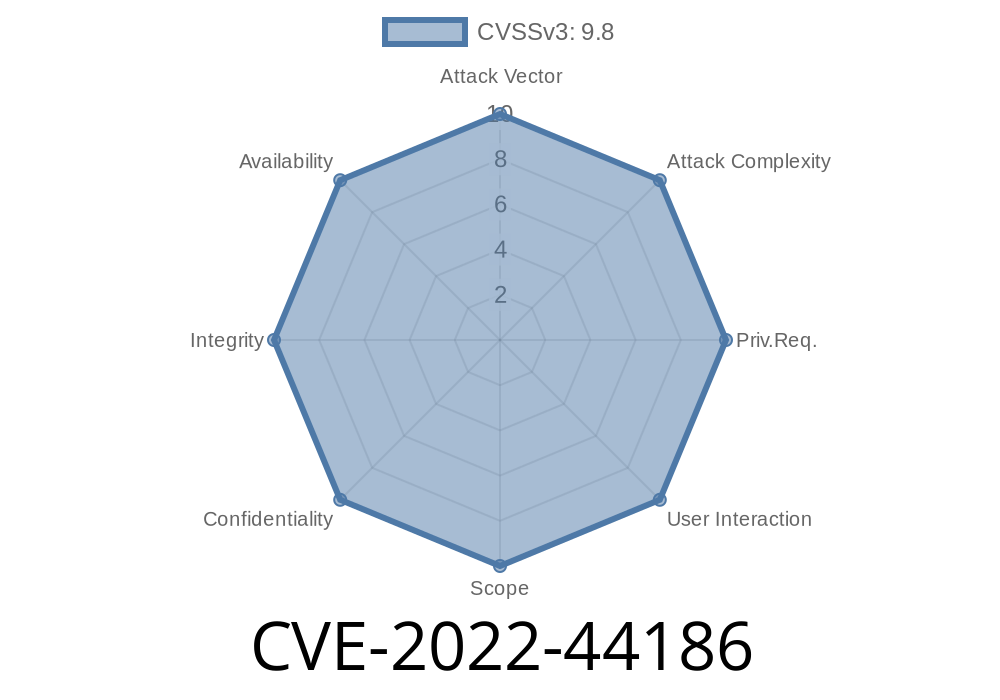A new vulnerability, marked as CVE-2022-44186, has been discovered in the firmware of the Netgear R700P router, specifically version 1.3.1.64. This security vulnerability results in a buffer overflow in the /usr/sbin/httpd process due to improper input validation in the 'wan_dns1_pri' parameter. This buffer overflow may potentially allow remote attackers to execute arbitrary code, compromise the affected router, and gain unauthorized access to sensitive information.
Affected Devices & Firmware
This vulnerability primarily affects the Netgear R700P router with firmware version 1.3.1.64. Users are advised to verify their device's model and firmware version to determine if they are at risk.
Technical Details
The buffer overflow vulnerability is a direct result of improper input validation in the 'wan_dns1_pri' parameter of the /usr/sbin/httpd process. By crafting an overly long string and sending it as the value for this parameter, a remote attacker can potentially trigger a buffer overflow that may lead to arbitrary code execution or a router crash.
The following code snippet illustrates this issue
POST /apply.cgi HTTP/1.1
Host: R700P's IP address
Content-Type: application/x-www-form-urlencoded
Content-Length: 141
submit_flag=dns_redir&submit_type=restart_process&wan_dns1_pri=A*A*... + Long_String + ..*A*A*&wan_dns1_sec=8.8.4.4&block_sites=1
Here, the attacker submits an HTTP POST request containing an excessively long string as the value for the 'wan_dns1_pri' parameter. This could cause the buffer overflow in the /usr/sbin/httpd process.
Exploit Details
An exploit for this vulnerability would involve an attacker crafting a malicious HTTP POST request containing an overly long string as the value for the 'wan_dns1_pri' parameter. This request could be sent to a targeted Netgear R700P router over the internet or via a local network. By successfully triggering the buffer overflow, the attacker may gain unauthorized access to the router, potentially allowing them to execute arbitrary code or obtain sensitive information.
To mitigate this vulnerability, users are advised to upgrade their router firmware to the latest version provided by Netgear. Furthermore, users should always monitor their network for any signs of unauthorized access and intrusion.
Original References
For detailed information about CVE-2022-44186 and its underlying vulnerability in the Netgear R700P router, please refer to the following sources:
1. (Original CVE Entry) https://cve.mitre.org/cgi-bin/cvename.cgi?name=CVE-2022-44186
2. (Netgear Security Advisory) https://www.netgear.com/support/product/R700P.aspx?cid=wmt_netgear_organic#FirmwareVersion
Conclusion
CVE-2022-44186 is a critical buffer overflow vulnerability affecting the Netgear R700P router running firmware version 1.3.1.64. This issue can potentially expose users to unauthorized access and arbitrary code execution by remote attackers. Protecting router security should be a top priority for any organization or individual, so always ensure your firmware is up to date to mitigate the risks associated with known vulnerabilities.
Timeline
Published on: 11/22/2022 14:15:00 UTC
Last modified on: 11/23/2022 19:08:00 UTC
